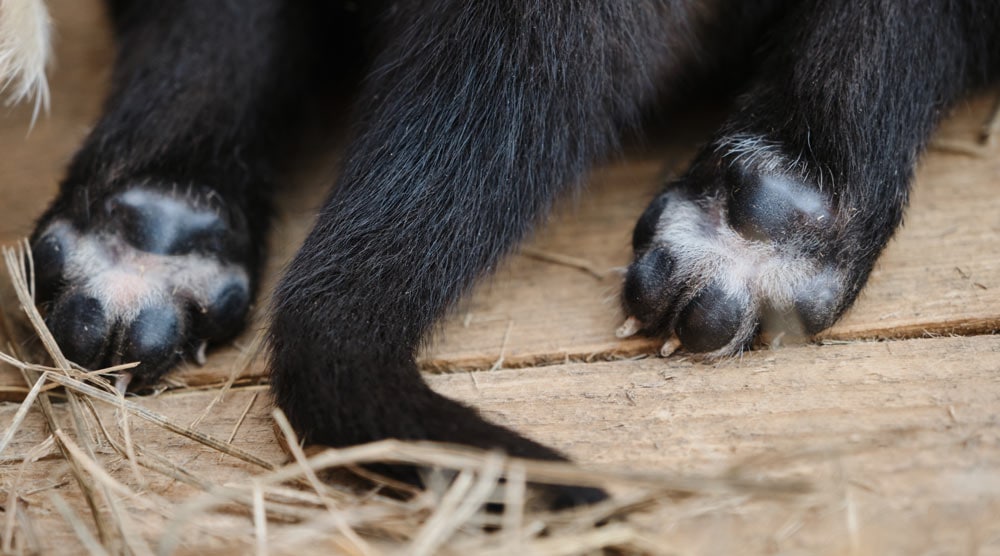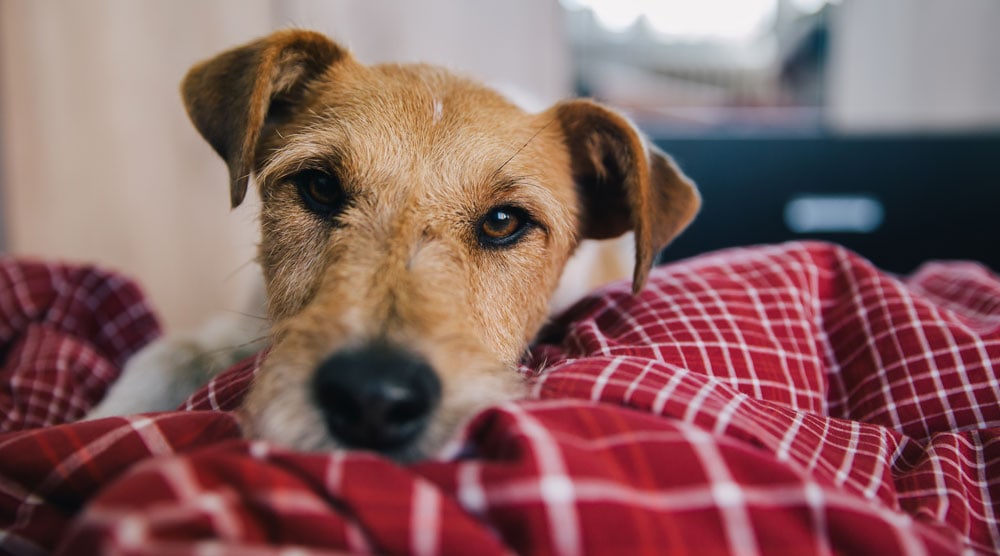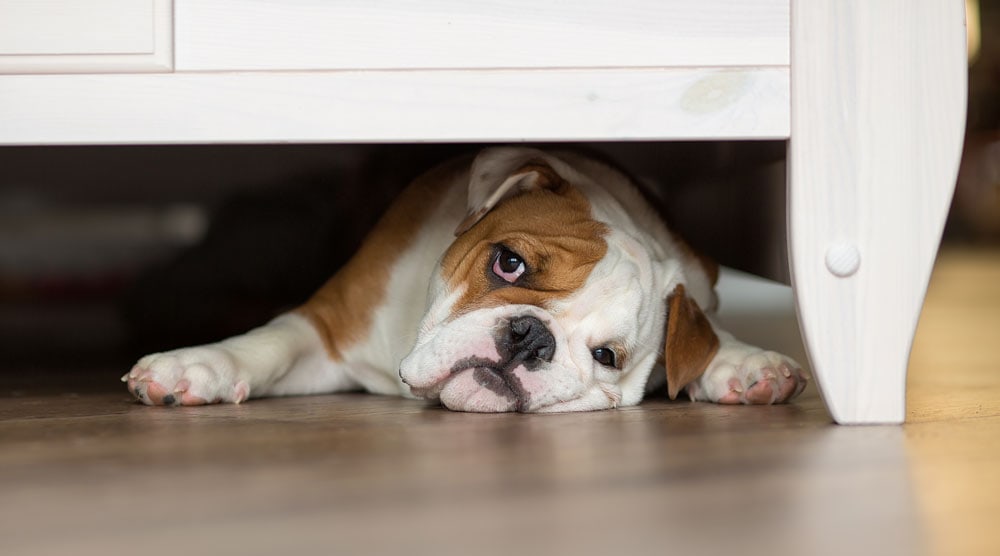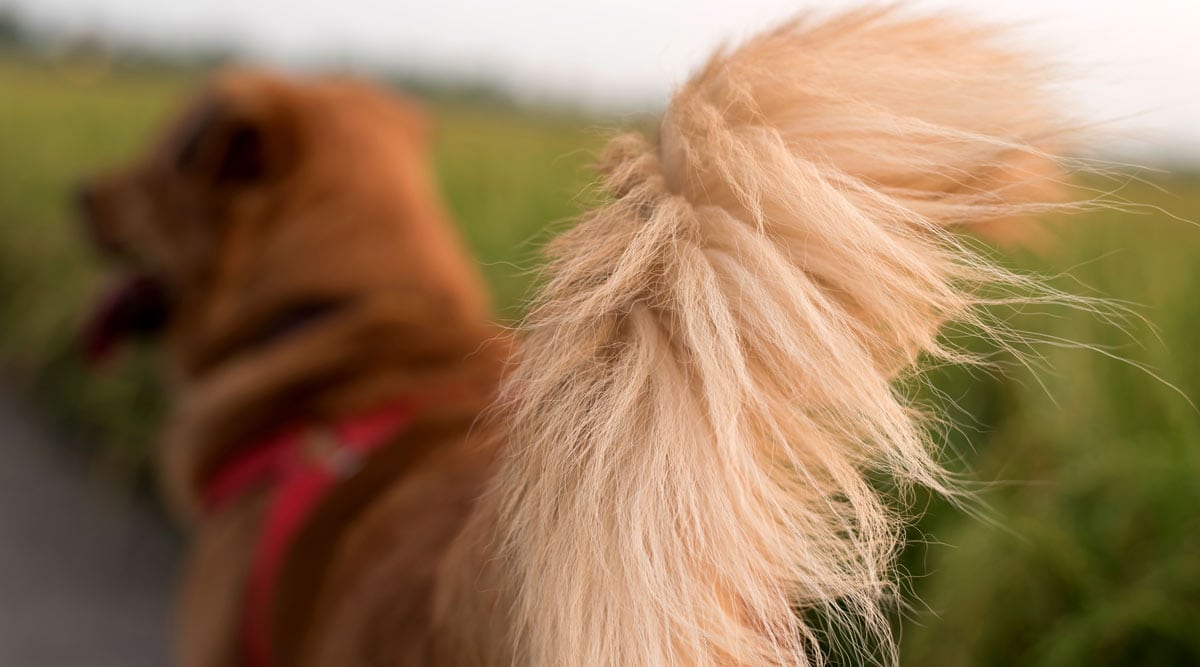Have you noticed your dog wagging their tail in sleep and wondered why? The most likely answer is that they’re dreaming!
In this article, we’ll discuss tail wagging during sleep and what it might mean. We’ll also talk about canine sleep cycles and when this behaviour might signal a medical problem.
Contents

Key Takeaways
- Dreams are the most common reason for a dog to wag its tail during sleep.
- Tail wagging can express a range of emotions, not just happiness (even during sleep).
- A wagging tail doesn’t affect a dog’s sleep quality. It is generally normal behavior that isn’t something to worry about.
- However, it’s crucial to differentiate tail wagging from violent twitching, which could indicate a seizure. Seizures require emergency veterinary care.
- Contact a vet if your dog’s sleep habits suddenly change or other symptoms appear.
The Language of Tail Wagging
Tail wagging is about much more than just showing happiness. Dogs use their tails to signal their emotions and how strongly they are feeling them, whether they are content, alert, or scared.
The key is how the tail wags. Wagging speed, position, and direction can all affect what a dog is trying to “say”.
An alert and tense dog, for instance, often holds its tail high and wags it at a rapid pace. On the flip side, a relaxed swish of the tail typically indicates a happy dog.
Interpreting tail body language becomes almost impossible when your pet is sleeping. But the main point is that a wagging tail during sleep doesn’t always mean they are happy.
Related Article: Why Do Dogs Have Tails?
Understanding Canine Sleep Cycles
Before we can understand why dogs wag their tails during sleep, we need to know the basics of canine sleep cycles.
Like humans, dogs go through two primary stages of sleep: light sleep and REM (Rapid Eye Movement) sleep. It’s during the REM stage of sleep that dogs dream and process memories.
However, a dog’s sleep cycle is much shorter than humans, at around 20 minutes compared to our 90 minutes. As a result, dogs spend less time in the deep, dreaming stage of REM sleep.
Dogs compensate for a shorter REM stage by napping throughout the day, following a polyphasic sleep schedule. They also enter REM sleep faster than humans.
The benefit of these short, frequent sleep cycles? Your pooch can feel rested and rejuvenated after just a quick power nap! But the downside is that dogs need to sleep for longer during a 24 hour period.
In general, an adult dog requires between 12 to 14 hours of sleep each day for optimal health and happiness.
Puppies, with their rapid mental and physical growth, may sleep up to a whopping 20 hours a day. If you’ve ever marveled at your puppy’s ability to doze off at a moment’s notice, now you know why!
Why REM Sleep Is Essential for Dogs
Getting enough high-quality sleep is just as crucial for dogs as it is for us humans.
Chronic sleep deprivation can cause a range of problems in dogs, from stress to lethargy. This can lead to behavioural changes and makes training more difficult. A lack of sleep can even weaken the immune system, making your dog more susceptible to illnesses.
The REM sleep phase is particularly important. During REM, the dog processes memories and repairs the body.
This is why sleep quality is just as important as quantity. If a dog fails to reach the REM stage, they won’t feel fully rested, even if they appear to sleep for long periods.
Here are some tips for helping your dog get enough high-quality sleep:
- Everyone in the household should understand not to disturb a sleeping dog. Dogs, like humans, find it hard to relax into deep sleep if they’re continually being awakened.
- Provide your dog with a safe and quiet space where they can retreat and relax.
- Buy your dog a comfortable bed that supports the joints. It should also be big enough for your dog to sleep in any position.
- If your dog is alert to noises, consider covering external sounds with white noise at night.
- Ensure your dog has a consistent routine. This helps maintain healthy circadian rhythms and improves sleep quality.
- Make sure your pet is getting enough exercise during the day. Pent-up energy makes it very difficult for a dog to sleep.
Why Might a Dog’s Tail Wag While Asleep?
The most likely explanation for a dog wagging its tail while sleeping is that they are dreaming.
Dreams primarily occur during the REM sleep phase. Hence, if your dog is both dreaming and wagging their tail, it indicates they’re in a deep sleep stage.
However, remember that tail wagging doesn’t always signify happiness. A wagging tail during sleep might suggest a joyful dream. But it could also be due to unpleasant emotions, like anxiety or fear, depending on the dream’s content.
Is It Normal For a Dog To Wag Their Tail While Sleeping?
Yes, it’s absolutely normal for dogs to wag their tails during dreams.
Sleep wagging shows that the dog is experiencing a strong emotion in the dream. Don’t worry, this won’t disrupt their sleep quality, and it typically doesn’t wake them up.
However, it’s important to know the difference between dreaming and seizures, as these may look similar.
Dreaming involves gentle, short-lived twitching and tail wagging. In contrast, seizures involve more violent twitching for prolonged periods.
Other seizure symptoms include foaming at the mouth and rigid limbs. The dog will also appear distressed when they wake up. Seizures are a medical emergency, so if you suspect your dog might be having one, contact a vet immediately.
Did you know…research has shown that smaller dogs tend to dream more than larger breeds, but with shorter dream durations. For instance, a large Labrador may have fewer dreams, but they could last up to 10 minutes. In contrast, a small Chihuahua might have more frequent dreams but for just 1-2 minutes each.
What Do Dogs Dream About?
By analyzing brainwaves during sleep, researchers have found that dogs have similar electric brain patterns to humans. This means that their dream mechanisms might be similar.
What exactly do dogs dream about though?
The exact content of dog dreams is still beyond our understanding. But it’s likely that they involve reliving events from their day. Examples might include strolls in the woods, car rides, squirrel chases, or even a nerve-wracking encounter with another dog.
Given the deep bonds between dogs and their owners, it’s also likely that you are a recurring character in your dog’s dreams!
Sadly, dogs can also have nightmares. During nightmares, the dog may appear upset, whimper, or show other signs of stress.
However, you should resist the urge to wake them, even if they seem distressed. Waking a dog from a dream can cause “sleep startle”, possibly resulting in a defensive bite before they realise what’s happening.
How Else Can You Tell If A Dog Is Dreaming?
Dog dreams mainly occur during the REM sleep stage. It takes time to reach this stage, so you’re more likely to notice dreaming when your dog is having a long sleep, rather than a short nap.
Besides a wagging tail, other signs of a dreaming dog include:
- Irregular breathing
- Whimpering or high-pitched barks
- Kicking or twitching legs (as if they’re running in their dream)
- Moving or twitching ears
When Should You Consult a Veterinarian?
Tail wagging, or other signs of dreaming during sleep, typically aren’t reasons for alarm.
However, contact your vet if you notice changes in your dog’s sleep habits or other potential illness symptoms. If your dog displays violent twitching or foaming at the mouth during sleep, seek immediate veterinary attention, as these could be signs of a seizure.
Summary
When your dog’s tail wags during sleep, it’s probably a sign that they are dreaming. This is a normal canine behavior that doesn’t disrupt their rest.
However, sudden changes in your dog’s sleep habits could indicate a health problem. Intense twitching could also be a seizure, which requires emergency veterinary care.
Do you have any questions about why dogs wag their tail while sleeping? Please let us know in the comments below.




